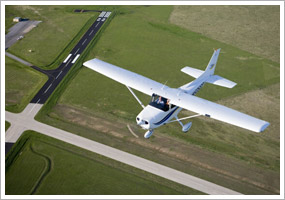THE ACTIVE RUNWAY
 Whether heading out to fly, or returning to land, one bit of information every pilot needs is an answer to the question, "What's the active runway?" At towered airports you'll get the answer on the automated weather recording or when ATC replies to your call-up with instructions: "Taxi to Runway 33." At nontowered airports, procedures are less formal, but usually the correct course of action is clear. Automated weather will provide surface winds. The fixed-base operator may respond to your request for an airport advisory with runway information. Or monitoring the common traffic advisory frequency may reveal which runway is "active."
Whether heading out to fly, or returning to land, one bit of information every pilot needs is an answer to the question, "What's the active runway?" At towered airports you'll get the answer on the automated weather recording or when ATC replies to your call-up with instructions: "Taxi to Runway 33." At nontowered airports, procedures are less formal, but usually the correct course of action is clear. Automated weather will provide surface winds. The fixed-base operator may respond to your request for an airport advisory with runway information. Or monitoring the common traffic advisory frequency may reveal which runway is "active."
Occasionally the runway in use seems badly matched to the winds. It could be that a student pilot is getting a lesson in crosswinds. Or a large aircraft may opt to use the longest runway available. Now you have a decision to make. "Remember, this is a nontowered airport. The fixed-base operator providing you with active-runway information is not an air traffic controller and cannot require you to land on a runway that you consider inappropriate, if, for example, winds favor another," explained the Sept. 16, 2005, "Training Tip: Airport Advisory."
Scenarios like that are common. "Whenever a student asks me what the active runway is, my response is to shrug my shoulders and reply, 'I don't know, you're the one landing the airplane, not me. If it were my landing to do I would probably pick the runway with the most favorable wind conditions," said one flight instructor in "Instructor Reports: Pattern Operations Revisited." The article also discusses the provocative case of a business jet and a single-engine training airplane seeking to use opposite ends of the same runway, a situation that raised challenging questions for all pilots.
What if the winds are calm? Then the runway choice is yours—in most cases. Prepare to fly by always checking AOPA's Airport Directory for any special procedures, such as this requirement in effect at Bar Harbor, Maine (BHB): "durg VFR conds when wind speed is less than 5 knots as rprtd by AWOS or UNICOM; all acft using ry 4-22 shall tkof & lnd ry 22."
If there's an active runway, make sure it is also the correct runway to use.
No comments:
Post a Comment